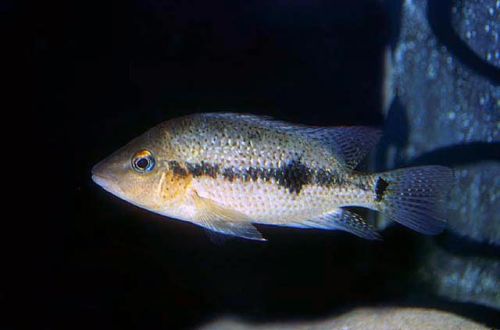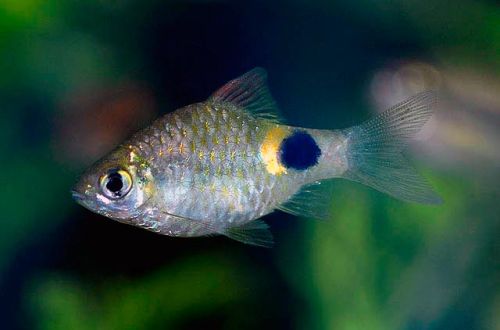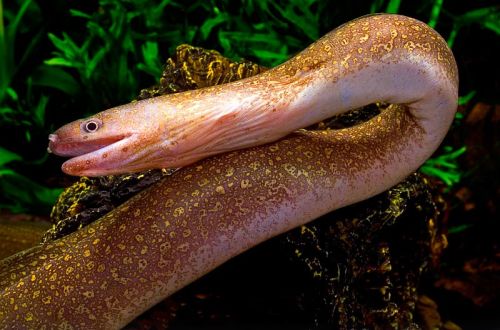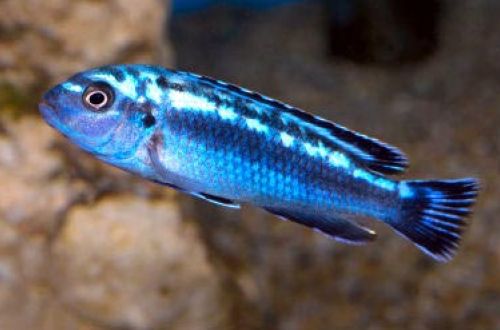
Melanochromis Johanna
Johan’s Melanochromis, scientific name Pseudotropheus johannii (other commonly used name Melanochromis johannii), belongs to the family Cichlidae. A beautiful bright cichlid, the coloration of males and females differs so much that many perceive them as two completely different species – the male is blue and the female is yellow.

This species belongs to the Mbuna cichlid group. It unites 13 genera of active and aggressive representatives living along the rocky shores. The word “Mbuna” is translated from the local dialect as “dwellers of the rocks.”
Melanochromis Johan is called “Electric Blue” in English-speaking countries, but another popular species of Mingano has been called similarly for many years, which has caused considerable confusion in the aquarium literature. Both species are very similar in appearance to each other and errors are observed to this day, on many sites the images of the species are still often confused.
Requirements and conditions:
- The volume of the aquarium – from 120 liters.
- Temperature – 23-28°C
- pH value – 7.0-8.0
- Water hardness – medium hardness (10–18 dH)
- Substrate type – sand with rocks
- Lighting – moderate
- Brackish water – allowed at a concentration of 1,0002
- Water movement – moderate
- Size – 7–8 cm.
- Nutrition – a combination of high-protein and plant foods
- Life expectancy – up to 12 years.
Habitat
They originate from Lake Malawi in Africa, live locally in the eastern part of the lake near the settlement of Masinje and Cape Ngombo on the territory of the modern state of the same name Malawi. They prefer to stay close to a heap of small and medium-sized rocks that go into the water to a depth of 5 meters. In the wild, they feed on hard fibrous algae that grow on rocks and small benthic invertebrates that live in these algae.
Description
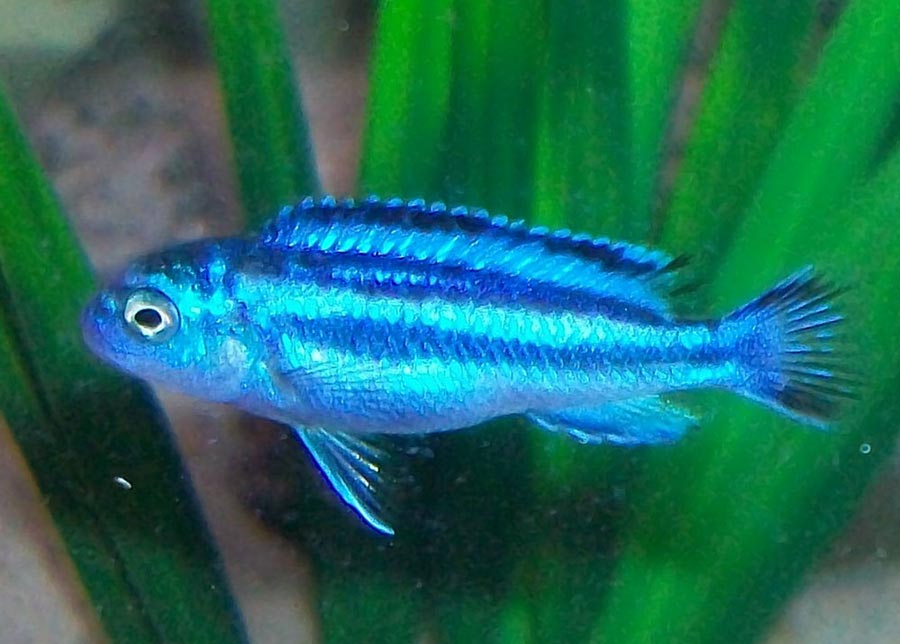
They have an elongated body with a rounded head and a long dorsal fin that runs from head to tail. Coloration depends on gender. The male is light blue in color with rows of parallel dark stripes. The anal fin has light spots resembling eggs in size and color. Females and juveniles have a golden-orange hue and barely noticeable body stripes. Due to the similarity in coloration, males are often mistaken for their close relative Mingano.
Food
It belongs to the omnivorous species of cichlids. Despite the omnivorous nature of the food should be varied, feeding the same type of food is not acceptable. In a home aquarium, you can feed live or frozen food (brine shrimp, daphnia, bloodworms) in combination with dry food (flakes, pellets, etc.) and herbal supplements. Serving animal products such as beef heart or liver is not recommended, although many publications state otherwise. The meat of mammals is not typical of their diet and can cause digestive problems, provoke the Malawian bloat disease. Feed 2-3 times a day with an amount that will be eaten within 5 minutes.
Maintenance and care
Melanochromis Johana requires high quality and stable water composition. At the same time, it does not differ in cleanliness, so it will be necessary to update the water weekly in an amount of 20% to 50%, depending on the size of the tank and the number of inhabitants. So, for 3-4 individuals and an aquarium size of 150 liters, the volume of water to be replaced will be 20%.
The composition of the water should repeat the natural conditions of Lake Malawi – slightly alkaline water of medium hardness, a small salt concentration is acceptable (2 grams per 1 liter). Read more about the composition and methods of changing the pH and dH parameters in the “Hydrochemical composition of water” section.
A filtration system is designed to help maintain the purity of water, purchase the most efficient filter available to you at a price. It will also provide the necessary internal flow. Equally important is high-quality aeration of water, due to the lack of plants in the aquarium. Provide several spray stones that form many small air bubbles. Other necessary equipment includes a heater and a lighting system.
In the design, it is necessary to reproduce the natural habitat. Soil of coarse sand with a heap of large rocks and stones rising to the very surface. the presence of shelters is mandatory, their functions are performed by various crevices and grottoes. There is no need for plants.
Behavior
Relatively tolerant species in relation to other cichlids. Aggressive behavior is observed between males and towards fish of a similar color, especially in Mingano. It is recommended to keep one male and 3-4 females, provided that there is a reliable shelter in the rocks for each. It is possible to keep a male / female in pairs, but in this case the degree of aggression will become too high, and in the presence of other neighbors, unwanted skirmishes may occur. As neighbors, you can use other non-aggressive cichlids of Lake Malawi, for example, Hummingbird Cichlid, Ocellaris Cichla, Lombardi, Lemon Cichlid and others.
Breeding / Reproduction
A polygamous species, a male and several females form a permanent family. Under favorable conditions, spawning can begin at any time. The main sign of the imminent mating season is an increase in the color intensity of the male. We can say that it becomes brighter twice.
Females lay from 10 to 60 eggs on the ground, and then immediately hide them in their mouths – this is an evolutionarily established way to save their offspring. However, they remain unfertilized, there is one interesting way for this. The pattern on the anal fin of the male resembles eggs, which the female mistakenly perceives as her own and tries to swallow them with her mouth. At this point, the male releases milk, which is inhaled by the female and fertilization occurs. The incubation period is from 14 to 21 days, all this time the eggs are in the female’s mouth. After the appearance, she will protect the offspring for several more days, in case of danger, the fry will hide in the female’s mouth. Juveniles can eat finely ground dry foods and brine shrimp nauplii – their larval stage.
Fish diseases
A typical disease for this species is Bloating Malawian. It occurs in the case of unsatisfactory food quality and a monotonous diet without herbal supplements. In addition, poor water quality reduces the immunity of fish and provokes various bacterial and fungal infections. The main preventive measure is to ensure proper water quality and housing conditions. Read more about symptoms and treatments in the Aquarium Fish Diseases section.
Features
- Content in the group – one male and several females
- Intolerant of similar blue-colored fish
- Food products must combine live, dry and plant foods



